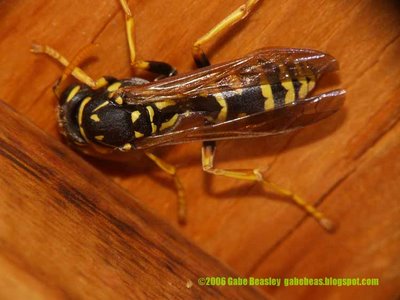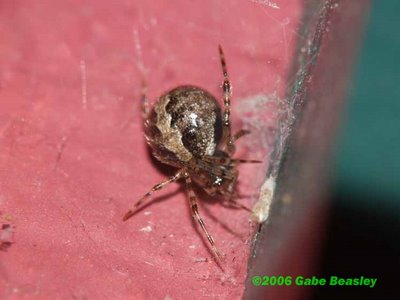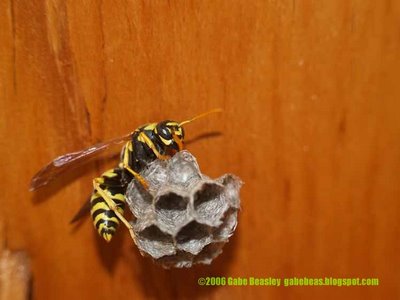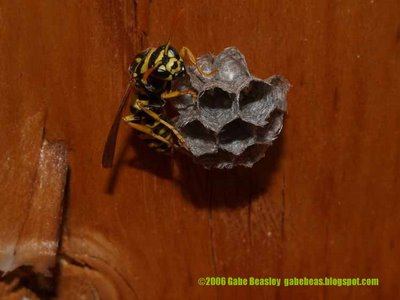 Yes-this is a sleeping hornet. But I won't lie to you. yes- this might hurt if you try this. If you find one like this be very careful not to wake her. This is a Sandhills Hornet (Vespula spp.) They are commonly found on a small paper nest (see more hornet pictures after the spiders). This one was not even aware of me. So asleep I could study her. She is pregnant, and was the lucky one that survived to be queen in another nest so that she can make one for herself, raising a family to help protect her. They go to a great deal of trouble to stay alive and are very good mothers.
Yes-this is a sleeping hornet. But I won't lie to you. yes- this might hurt if you try this. If you find one like this be very careful not to wake her. This is a Sandhills Hornet (Vespula spp.) They are commonly found on a small paper nest (see more hornet pictures after the spiders). This one was not even aware of me. So asleep I could study her. She is pregnant, and was the lucky one that survived to be queen in another nest so that she can make one for herself, raising a family to help protect her. They go to a great deal of trouble to stay alive and are very good mothers. She holds her head down away from my bug lights like any sleeping animal. I bet you never expected that in an Insect. She has probably flown many miles to find a place to build her small nest and colony in range of the hector and other things she needs. She will start building tomorrow.
She holds her head down away from my bug lights like any sleeping animal. I bet you never expected that in an Insect. She has probably flown many miles to find a place to build her small nest and colony in range of the hector and other things she needs. She will start building tomorrow. And she did not so much as raise her head when I lit her up with my flash and macro-spot light. Now most people would be grabbing for a can of bug spray--but here this, these are living creatures and as I will explain--these nectar eating insects only usually sting when people do stupid things around or with them. Bug spray is only one way get them away. This one never woke up despite having taken several high-powered close-pictures. Shooting at f22 for depth of field--I need a pretty bright flash to get results. She was sound asleep.
And she did not so much as raise her head when I lit her up with my flash and macro-spot light. Now most people would be grabbing for a can of bug spray--but here this, these are living creatures and as I will explain--these nectar eating insects only usually sting when people do stupid things around or with them. Bug spray is only one way get them away. This one never woke up despite having taken several high-powered close-pictures. Shooting at f22 for depth of field--I need a pretty bright flash to get results. She was sound asleep. WHAT A CATCH This girl caught a big one! This is an example of the sheet web spider at it's best. Spiders use there minds, not just there instinct and weapons. This one was on the side of a wall having caught this massive moth which must have been very hard to subdue. She let me take quite a few pictures of her.
WHAT A CATCH This girl caught a big one! This is an example of the sheet web spider at it's best. Spiders use there minds, not just there instinct and weapons. This one was on the side of a wall having caught this massive moth which must have been very hard to subdue. She let me take quite a few pictures of her. This is interesting because these spiders are pure-web builders. Yet this one strayed out and acted like a wolf spider or crab spider. It's web and hideout were probably destroyed in the attempt to get this moth--it's not necessary. In fact most spiders can be hand-fed--because they are aware of the kinds of insects that they feed on and will respond to help. I’ve actually brought spiders back by hand-feeding them. So here she breaks the "rules" by wrangling down this huge moth and holding it steady in her grip of death. A real show of how spiders use there brains as well as there webs--the unexpected is what has kept me interested in spiders for all these years. You never really know them and what they can do. They are not predictable like chickens, and most insects.
This is interesting because these spiders are pure-web builders. Yet this one strayed out and acted like a wolf spider or crab spider. It's web and hideout were probably destroyed in the attempt to get this moth--it's not necessary. In fact most spiders can be hand-fed--because they are aware of the kinds of insects that they feed on and will respond to help. I’ve actually brought spiders back by hand-feeding them. So here she breaks the "rules" by wrangling down this huge moth and holding it steady in her grip of death. A real show of how spiders use there brains as well as there webs--the unexpected is what has kept me interested in spiders for all these years. You never really know them and what they can do. They are not predictable like chickens, and most insects. Here is a tiny spider you probably have in your home but never even notice. Being about 3mm large- that’s why. It's web is smaller then a gum wrapper and it can go without food for an entire winter in a garage. These tiny spiders are one of my favorite since they can be found in even the most clean-kept houses. DON"T kill them--not only are they most definitely harmless to humans entirely due to there size--there principle food is ANTS. They work allot better then those little ant traps. I'm the only one between a few of houses here that does not have an ant problem. My ants are all caught by the spiders in the basement and the few small ones that live in corners. The neighbors continue using bug spray and all kinds of stuff you can buy with little or know results. A serialized world, is that what we want? Nature won't give that to us. Human beings have as much right to live as any other animal. We may say we own property--but do we really? We are a part of nature no matter how much we want to try to trick ourselves into thinking that we are not. And we have to live with nature in order to survive-no matter how often we try to tell ourselves it's ok to feel that all other living things don't feel anything and are mindless robots that we can kill just because it's "our house". Inevitably we must find a way to de-bunk the fear and myths we have about ourselves and the creatures that live with us.
Here is a tiny spider you probably have in your home but never even notice. Being about 3mm large- that’s why. It's web is smaller then a gum wrapper and it can go without food for an entire winter in a garage. These tiny spiders are one of my favorite since they can be found in even the most clean-kept houses. DON"T kill them--not only are they most definitely harmless to humans entirely due to there size--there principle food is ANTS. They work allot better then those little ant traps. I'm the only one between a few of houses here that does not have an ant problem. My ants are all caught by the spiders in the basement and the few small ones that live in corners. The neighbors continue using bug spray and all kinds of stuff you can buy with little or know results. A serialized world, is that what we want? Nature won't give that to us. Human beings have as much right to live as any other animal. We may say we own property--but do we really? We are a part of nature no matter how much we want to try to trick ourselves into thinking that we are not. And we have to live with nature in order to survive-no matter how often we try to tell ourselves it's ok to feel that all other living things don't feel anything and are mindless robots that we can kill just because it's "our house". Inevitably we must find a way to de-bunk the fear and myths we have about ourselves and the creatures that live with us. The things I do for the right shot! I am not shy with my camera. If I want a shot I will get it. Even here! These wasps are common here. This one has a small colony started. It is a large yellow jacket or Sandhills Hornet as shown sleeping (above pictures). This single female who has already mated with a male to start a new nest will try her best. She has made all the paper for this complex small start with her spit and cleverness. They make paper good enough to write on.
The things I do for the right shot! I am not shy with my camera. If I want a shot I will get it. Even here! These wasps are common here. This one has a small colony started. It is a large yellow jacket or Sandhills Hornet as shown sleeping (above pictures). This single female who has already mated with a male to start a new nest will try her best. She has made all the paper for this complex small start with her spit and cleverness. They make paper good enough to write on. Most people would already have a can of bug spray. But I have an alternative if you care. First off--most people get stung because they do stupid things with these. This one, on a warm spring day--let me take these pictures with less then six inches between my lens and her nest. After a few flashes she got a little spooked, but I did not get stung. Dealing with these hornets if they are in a bad spot is relatively easy. Use a GARDEN HOSE FROM A DISTANCE to spray clean the nest. Hopefully you will have enough hose power to knock the nest off. Keep spraying it day after day whenever you think of it. They will find that the conditions are intolerable and move. Especially when the nest is destroyed they will chose to move on quickly--but you have to keep attacking them. DO THIS FROM A DISTANCE. If they associate you with the water they will sting. But I always deal with them this way and I can't recall the last time I got stung-
Most people would already have a can of bug spray. But I have an alternative if you care. First off--most people get stung because they do stupid things with these. This one, on a warm spring day--let me take these pictures with less then six inches between my lens and her nest. After a few flashes she got a little spooked, but I did not get stung. Dealing with these hornets if they are in a bad spot is relatively easy. Use a GARDEN HOSE FROM A DISTANCE to spray clean the nest. Hopefully you will have enough hose power to knock the nest off. Keep spraying it day after day whenever you think of it. They will find that the conditions are intolerable and move. Especially when the nest is destroyed they will chose to move on quickly--but you have to keep attacking them. DO THIS FROM A DISTANCE. If they associate you with the water they will sting. But I always deal with them this way and I can't recall the last time I got stung-the ones in Hawaii are more aggressive then these out here. Sometimes I use a very large jar with a wide lid to cover the nest at night--then move the jar until the nest torn and knocked off into the jar while keeping the jar sealed on the surface so none of them can get out. Then be ready with the lid to CALMLY but quickly trap them. Take the jar anywhere a ways away and throw it. They will probably find a new place to live.
WHAT I DO TO DEAL WITH HORNETS AND WASPS
I don't ever use insect spray, or those horrible traps. The traps are a complete rip-off. They attract more hornets then they keep away. The chemicals in them cause hornets to come from all over to possibly die in your back-yard--but not before they might sting someone. Most of those traps and glues bring more hornets then you had before. I don't use spray for more reasons then the hornets. Insect spray does not define what it kills (including humans) and is dangerous to everything it comes in contact with. I don't believe they should sell the stuff. We are part of nature and until we realize how to get along with nature---we will be seriously damaging our environment. The way to really prevent them is to find a way to build a house that does not have a surface they can make a nest on--or a surface that's out of the way which will attract them. I have comfortably lived with rather large hives above me and never been stung. Take it or leave it--my beliefs in these matters are very strong and come from years of experience. If I get stung---I will post it here. I was not even attacked when I shot those very close up pictures but I was pushing my luck getting that close. I should have possibly used a longer macro lens.
No comments:
Post a Comment